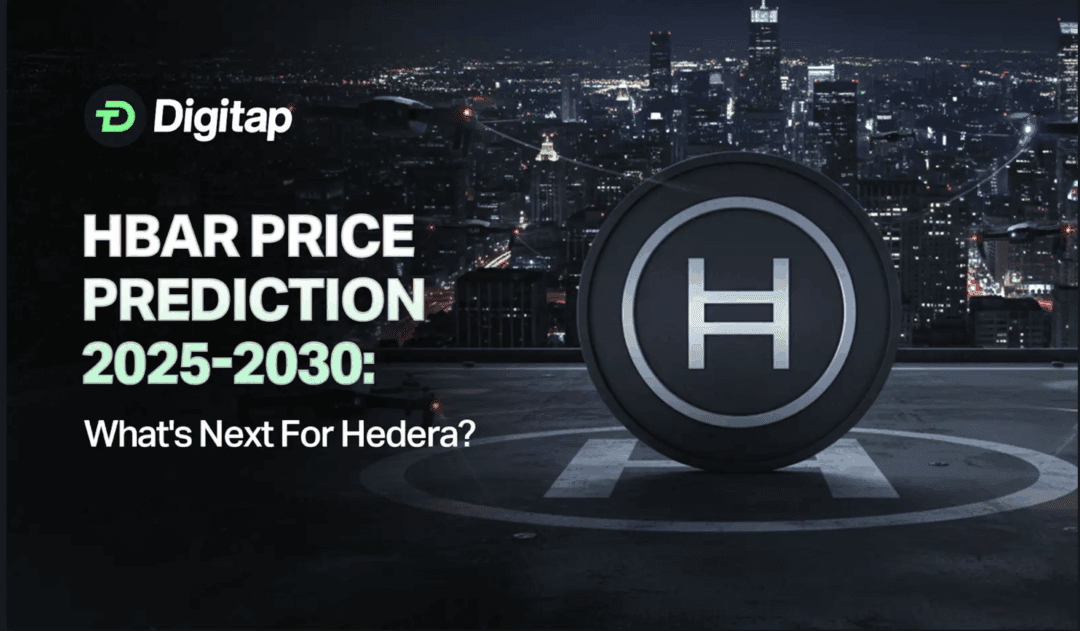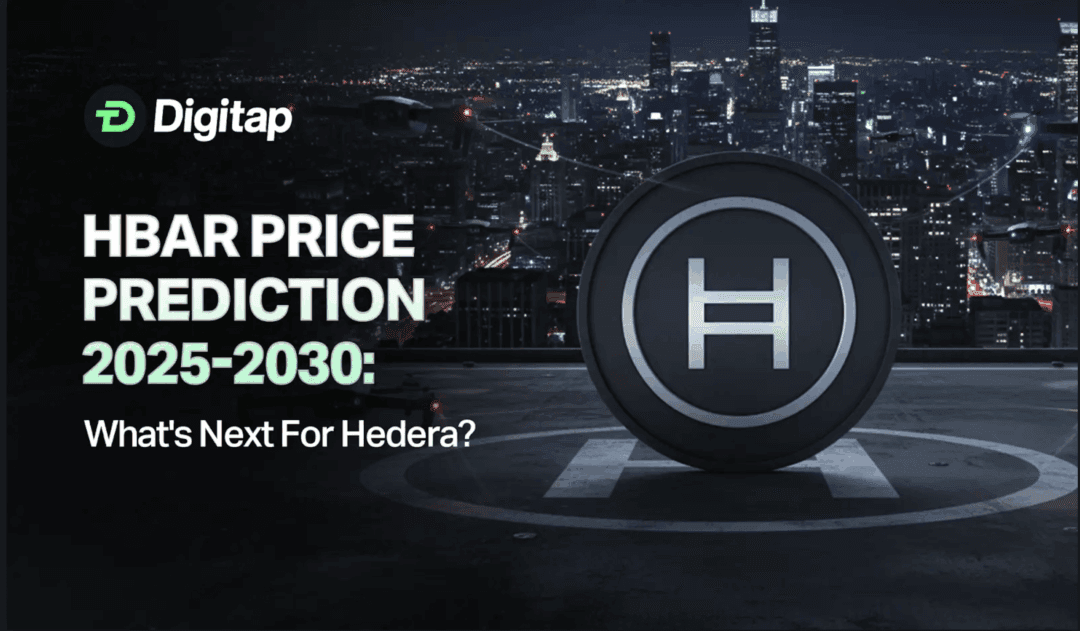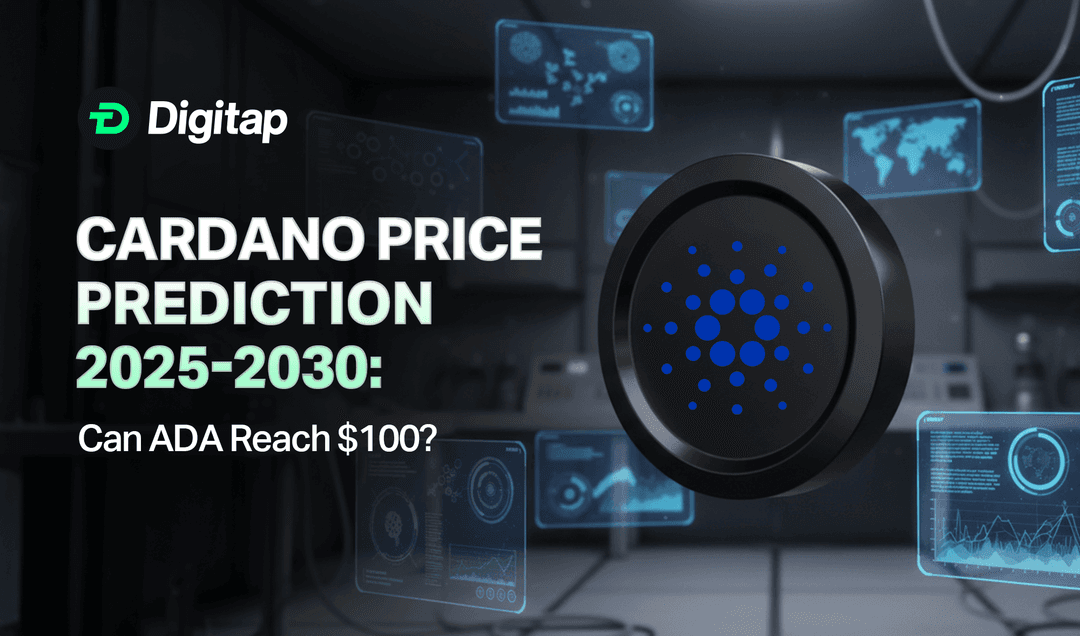HBAR Price Prediction 2025-2030: What's Next For Hedera?
October 30, 2025
Could Hedera Hashgraph be the enterprise blockchain that finally bridges the gap between traditional business and distributed ledger technology? With its unique hashgraph consensus and growing enterprise partnerships, many investors who are looking to buy crypto during short-term downturns are wondering what’s next for HBAR’s price trajectory through 2030.
HBAR is the native cryptocurrency that powers every aspect of the Hedera network, from processing transactions and executing smart contracts to securing the platform through staking mechanisms. Built with enterprise needs in mind, this token economy creates sustainable demand as businesses adopt Hedera for mission-critical applications.
This comprehensive analysis examines Hedera’s price potential from 2025 to 2030, analyzing technical indicators, enterprise adoption, fundamental factors, and market conditions that could drive HBAR’s future performance.
Understanding Hedera: Technology and Fundamentals
Hedera employs a patented hashgraph consensus mechanism built on a directed acyclic graph (DAG) structure that enables parallel transaction processing. This network architecture allows Hedera to achieve high throughput of over 10,000 transactions per second with low latency finality in just 3-5 seconds, vastly outperforming Bitcoin’s 7 TPS and Ethereum’s 15 TPS.
The HBAR token serves as the native cryptocurrency powering the Hedera network. It facilitates transaction fees, smart contract execution, and network security through staking. What sets HBAR apart is its role in an enterprise-focused ecosystem designed for real-world business applications rather than speculative trading.
Hedera’s consensus mechanism achieves asynchronous Byzantine Fault Tolerance (aBFT), the gold standard for distributed systems security. This ensures the network can reach consensus even if up to one-third of nodes are compromised or offline, providing enterprise-grade reliability that traditional businesses demand.
Hedera operates under a governing council of up to 39 leading global organizations, including Google, IBM, Dell, Boeing, and Deutsche Telekom. These council members run network nodes and guide platform development, providing the institutional stability and oversight that traditional businesses demand.
Hedera Project Fundamentals
Beyond its technological capabilities, Hedera’s strength lies in its comprehensive ecosystem of leadership, partnerships, and economic design that supports sustainable enterprise adoption.
Development Team: Hedera was co-founded by Dr. Leemon Baird, inventor of the hashgraph consensus algorithm and expert in distributed systems, and Mance Harmon, a technology executive with extensive experience in cybersecurity and enterprise solutions. The team combines deep technical expertise in distributed ledger technology with practical understanding of enterprise blockchain requirements.
Technology Innovation: Hedera’s hashgraph consensus provides unique competitive advantages including parallel transaction processing, guaranteed finality in seconds, and energy efficiency that surpasses traditional proof-of-work and proof-of-stake systems. The platform supports native tokenization services and smart contract execution while maintaining enterprise-grade compliance features.
Use Cases: Real-world applications span multiple industries, from supply chain tracking and carbon credit management to digital identity verification and cross-border payments. The network enables tokenization of assets, decentralized file storage, and consensus timestamping for audit trails and regulatory compliance.
Enterprise Partnerships: Major corporations including ServiceNow, Lloyds Banking Group, and Philippine banks actively build solutions on Hedera. The DIFC Courts in UAE utilize Hedera for digital notary services, while partnerships with NVIDIA and SpaceX demonstrate the platform’s versatility across sectors.
Tokenomics: HBAR has a fixed maximum supply of 50 billion tokens with 42.4 billion currently in circulation. Network fees paid in HBAR create natural demand, while staking rewards incentivize network security. Token release follows a predetermined schedule with treasury management overseen by the governing council.
HBAR Price History and Current Market Position
HBAR’s ICO price in 2018 was $0.12, but the token opened trading at approximately $0.036 when it launched publicly in September 2019. This initial decline reflected typical post-ICO market dynamics as supply entered circulation during a period when enterprises were still cautious about blockchain adoption.
Key price milestones include breaking above $0.10 in early 2021, reaching $0.39 during the spring crypto surge, and achieving its all-time high of $0.51 in September 2021. These levels corresponded with major enterprise announcements, including new council member additions and real-world implementation news.
During different market cycles, HBAR has shown distinct patterns. The 2021 bull market saw the token surge over 1,300% from its lows, while the 2022 bear market resulted in an 85% decline to around $0.035. Unlike purely speculative tokens that lost 95%+ of their value, HBAR’s enterprise utility provided relative stability during market downturns.
Current Market Metrics
As of mid-October 2025, HBAR trades around $0.16, showing resilience after bouncing from $0.10 in early October. The token reached a 2025 high of $0.40 in January before experiencing volatility throughout the year. With a market capitalization of approximately $7.2 billion, HBAR maintains its position among the top 50 cryptocurrencies.
Daily trading volumes typically range from $150-400 million, indicating strong liquidity and institutional participation. The token is widely available on major exchanges including Binance, Coinbase, and Kraken, meaning investors can buy ETH, Bitcoin and other cryptoscrypto through various platforms while monitoring live crypto prices for optimal entry points.
Technical Analysis for HBAR Price Prediction
Current technical analysis focuses on key support and resistance levels following recent extreme volatility. HBAR has established a strong support zone between $0.10-$0.14, which has provided a solid foundation after the recent decline. The next significant resistance level sits at $0.20, representing a crucial breakout point.
Key Technical Levels:
- Strong Support Zone: $0.10-$0.14
- Immediate Resistance: $0.20
- Major Resistance: $0.40 (recent 2025 high)
A break above $0.20 resistance would likely signal further upside momentum toward the recent $0.40 high achieved in January 2025. The 7-day RSI currently sits at 41.32, indicating neither overbought nor oversold conditions, providing room for movement in either direction based on fundamental catalysts.
Price Target Methodology
Fibonacci retracements use mathematical ratios to identify potential support and resistance zones where price reversals often occur. The 61.8% retracement level around $0.17 is currently acting as resistance, with price struggling to break above this key technical level.
Moving Average Analysis shows HBAR trading near its 200-day simple moving average around $0.20 a critical level for determining medium-term trend direction. A decisive break above this level could signal renewed bullish momentum.
Volume Analysis reveals accumulation patterns during price consolidation, suggesting institutional positioning ahead of potential catalysts like enterprise announcements or regulatory developments.
Fundamental Analysis and Growth Drivers
Hedera’s transformation from a promising enterprise blockchain to an actively adopted network accelerated throughout 2025. The newly launched Hedera Enterprise Adoption Team (HEAT) marks a strategic shift from simply expanding the governing council to actually converting those partnerships into real ecosystem activity.
Major financial institutions like State Street, Fidelity, and LGIM have moved beyond governance roles to actively using Hedera for asset tokenization. This demonstrates genuine utility rather than just corporate backing, with real money and real applications driving network usage.
The numbers reflect this enterprise momentum. Network transaction throughput jumped 22% month-over-month while smart contract deployments increased 15% as developers focus on tokenized real-world assets. With over 20 billion cumulative transactions processed, Hedera increasingly behaves like enterprise infrastructure rather than speculative technology.
When Australia’s Reserve Bank selected Hedera for Project Acacia, a wholesale CBDC pilot, it validated the network’s regulatory standing in ways that resonate with institutional adopters. Perhaps most intriguingly, Hedera’s positioning at the intersection of AI and blockchain through partnerships with NVIDIA and EQTY Lab addresses two transformative technologies simultaneously.
The challenges remain typical of enterprise adoption cycles. Slow implementation timelines and regulatory uncertainty persist, but recent upgrades including Ethereum compatibility and open-source protocol donation to the Linux Foundation show Hedera adapting to developer needs while preserving the enterprise reliability that distinguishes it from consumer-focused blockchains.
HBAR Price Prediction 2025: Short-Term Outlook
Conservative Scenario: $0.25-$0.35
Under conservative assumptions, HBAR could reach $0.25-$0.35 by the end of 2025, representing 56-119% growth from current levels around $0.16. This scenario assumes moderate enterprise adoption, stable regulatory environments, and continued development progress without major market disruptions.
Key drivers for this conservative case include:
- Steady growth in Hedera’s enterprise partnerships
- Gradual increase in network transaction volume
- Continued development of real-world use cases
- Stable cryptocurrency market conditions
Moderate Growth Scenario: $0.40-$0.60
A moderate growth scenario projects HBAR reaching $0.40-$0.60 by 2025, assuming accelerated enterprise adoption and successful deployment of major enterprise solutions. This 150-275% appreciation would likely result from:
- Significant increase in network utility from HEAT initiatives
- Major enterprise announcements from council members
- Successful integration of AI and blockchain technologies
- Positive regulatory developments for enterprise blockchain
Optimistic Projection: $0.70-$0.80
The most bullish 2025 scenario envisions HBAR reaching $0.70-$0.80, representing 338-400% growth from current levels. This outcome would likely require:
- HBAR ETF approval and institutional capital inflows
- Major enterprise blockchain adoption breakthrough
- Significant cryptocurrency market bull run
- Multiple large-scale Hedera implementations going live
Technical Catalysts for 2025:
- Breaking above $0.20 resistance could trigger momentum toward the recent $0.40 high
- Strong support zone between $0.10-$0.14 provides downside protection
- Recent bounce from $0.10 support demonstrates buying interest at key levels

HBAR Price Prediction 2030: Long-Term Vision
By 2030, blockchain technology is expected to reach mainstream adoption across industries. Hedera’s early focus on enterprise use cases positions it advantageously for this transition. If current development trends continue, Hedera could become the de facto standard for enterprise blockchain infrastructure.
Projected Network Capabilities by 2030:
- Support for millions of transactions per second through sharding
- Complete interoperability with major blockchain networks
- Advanced AI integration for automated smart contract execution
- Quantum-resistant security measures
Long-Term Price Projections
Conservative 2030 Target: $1.50-$2.00
Assuming steady 15-20% annual growth in enterprise adoption and network utility, HBAR could reach $1.50-$2.00 by 2030. This represents approximately 838-1,150% growth from current levels over six years – ambitious but achievable given the projected blockchain market expansion.
Moderate 2030 Target: $3.00-$5.00
Under accelerated adoption scenarios where Hedera captures significant market share in enterprise blockchain solutions, prices could reach $3.00-$5.00. This would require:
- Hedera becoming a primary infrastructure layer for major industries
- Significant increase in transaction volume and fee generation
- Successful integration with emerging technologies like IoT and AI
- Market capitalization reaching $150-250 billion
Optimistic 2030 Target: $8.00-$15.00
The most bullish projections suggest HBAR could reach $8.00-$15.00 if Hedera achieves dominant market position in enterprise blockchain. While ambitious, this scenario considers:
- Mass adoption of blockchain across all major industries
- Hedera’s governance model proving superior for enterprise needs
- Significant token burn mechanisms from high network usage
- Cryptocurrency market expansion to $10+ trillion total market cap
Supply Dynamics and Token Economics
HBAR’s tokenomics play a crucial role in long-term price potential. With a fixed maximum supply of 50 billion tokens and current circulation of 42.4 billion, the remaining 7.6 billion tokens will be released according to a predetermined schedule. Heavy unlock events, such as the 3.84 billion tokens released in January 2025, create short-term selling pressure but also increase long-term scarcity.
Network fees paid in HBAR create natural demand that could support price appreciation as usage grows. Unlike inflationary cryptocurrencies, HBAR’s capped supply means increasing demand directly translates to price pressure.
Risk Factors and Investment Considerations
Technology and Competition Risks
Competitive Landscape: Hedera faces significant competition from established players like Ethereum and other DAG-based networks. Success depends on maintaining technological advantages and expanding enterprise adoption faster than competitors.
Regulatory Uncertainty: While Hedera’s governance model provides regulatory clarity compared to decentralized networks, changing regulations could impact enterprise adoption rates or require costly compliance modifications.
Technology Evolution: Rapid advancement in blockchain technology could potentially obsolete current approaches. Hedera’s commitment to continuous development helps mitigate this risk, but technology shifts remain unpredictable.
Market and Economic Risks
Cryptocurrency Market Correlation: Despite its enterprise focus, HBAR prices remain correlated with broader cryptocurrency market movements. Major market downturns could significantly impact price appreciation regardless of fundamental progress.
Enterprise Adoption Timing: Corporate blockchain adoption often occurs slower than projected due to regulatory requirements, integration complexity, and budget cycles. Delayed adoption could limit near-term price appreciation.
Economic Downturns: Global economic challenges could reduce enterprise technology spending, potentially slowing Hedera adoption and impacting HBAR demand.
Investment Strategy Recommendations
Risk Management: Given cryptocurrency volatility, HBAR should represent only a portion of a diversified portfolio. Consider position sizing based on personal risk tolerance and investment timeline.
Dollar-Cost Averaging: Systematic investment approaches can help manage volatility and reduce timing risk. Regular purchases using a secure crypto swapping app during market downturns may provide better average entry prices.
Long-Term Focus: Hedera’s enterprise adoption thesis requires patience. Short-term price movements may not reflect fundamental progress, making long-term holding strategies potentially more suitable.
Secure Storage: For long-term holdings, consider secure digital wallet solutions, like DigiTap, that allow participation in network staking while maintaining complete control of assets.
Expert Opinions and Market Predictions
Analyst Consensus
Industry analysts show mixed projections for HBAR’s long-term prospects. CoinCodex forecasts modest 2025 growth with HBAR trading between $0.17-$0.31, while their 2030 prediction ranges from $0.19-$0.62 on the conservative end. More optimistic analysts at Coinpedia project stronger growth, with 2026 targets of $0.45-$1.05 and 2030 predictions reaching $0.95-$2.20.
The wide variance in predictions reflects uncertainty about enterprise adoption timing and market conditions. Technical analysts emphasize that breaking key resistance levels will be crucial for confirming bullish momentum, with enterprise adoption progress serving as the primary catalyst for future price movements.
Institutional Sentiment
Growing institutional interest is evident in expanding trading volumes and council membership. The potential for an HBAR ETF, similar to recent Bitcoin ETF approvals, could provide additional institutional access and price support.
Venture capital investment in Hedera ecosystem projects continues growing, with firms recognizing the potential for enterprise blockchain solutions. This institutional backing provides credibility and resources for continued development.
Conclusion: Hedera’s Path Forward
Hedera Hashgraph represents one of the most compelling enterprise blockchain investments available today. Its unique combination of technological innovation, institutional backing, and real-world utility creates multiple pathways for significant price appreciation through 2030.
Key Investment Thesis Points:
- Technology Leadership: Hashgraph consensus provides genuine advantages over traditional blockchains
- Enterprise Focus: Governance model and partnerships position Hedera for institutional adoption
- Market Timing: Early positioning in enterprise blockchain could yield significant returns
- Risk Management: Conservative price targets still offer substantial upside potential
While short-term volatility remains likely, Hedera’s fundamental strengths suggest strong long-term potential. Conservative projections indicate 838-1,150% growth potential by 2030, while optimistic scenarios suggest even greater appreciation.
The convergence of regulatory clarity, technological maturation, and enterprise digital transformation creates a favorable environment for Hedera’s continued growth. Investors willing to embrace the inherent volatility of cryptocurrency markets while focusing on long-term fundamentals may find HBAR an attractive addition to diversified portfolios.
Ready to position yourself for Hedera’s enterprise blockchain growth? Secure your HBAR holdings with DigiTap’s self-custody solution and participate in network staking while maintaining complete control of your assets.
Frequently Asked Questions
What is Hedera Hashgraph (HBAR) and how does it differ from blockchain?
Hedera uses hashgraph consensus algorithm instead of traditional blockchain, enabling faster transactions (10,000+ TPS), lower costs ($0.001-$0.01), and better energy efficiency while maintaining enterprise-grade security.
What are realistic HBAR price targets for 2025 and 2030?
Conservative 2025 targets range from $0.25-$0.60, while 2030 projections suggest $1.50-$5.00 based on enterprise adoption rates and market conditions.
What factors could drive HBAR price growth in the coming years?
Key drivers include enterprise blockchain adoption, Hedera Council member implementations, regulatory clarity, potential ETF approval, and integration with AI and IoT technologies.
How does enterprise adoption affect HBAR’s long-term price potential?
Enterprise adoption drives network usage, creating natural demand for HBAR tokens through transaction fees, smart contract execution, and staking rewards.
What are the main risks of investing in HBAR long-term?
Primary risks include competition from other blockchain platforms, delayed enterprise adoption, regulatory changes, broader cryptocurrency market volatility, and technological disruption.
Where can I safely store and stake my HBAR tokens?
HBAR can be stored in hardware wallets, exchange wallets, or self-custody solutions like DigiTap’s platform, which enables staking while maintaining complete asset control.
How do I analyze HBAR’s price charts for trading decisions?
Focus on key support/resistance levels ($0.20-$0.23 range), moving averages, volume patterns, and broader cryptocurrency market trends while considering fundamental developments.
Should I stake my HBAR tokens for additional rewards?
Staking provides passive income through network validation rewards while contributing to network security. Consider staking for long-term holdings, but ensure you maintain access to tokens when needed.
How does Hedera’s governing council impact HBAR price predictions?
The council provides stability and credibility that appeals to institutional investors, while member implementations create real network utility that supports long-term value appreciation.
What role does transaction volume play in HBAR’s future value?
Higher transaction volume generates more network fees paid in HBAR, creating natural buying pressure and demonstrating real-world utility that supports fundamental valuation.
Share Article







